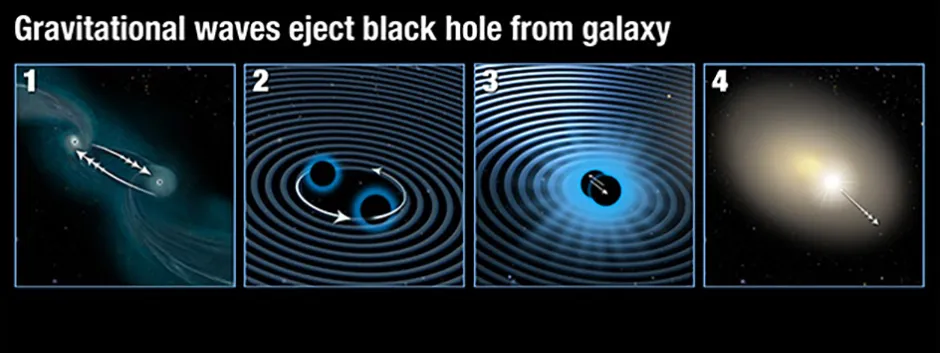Astronomers have spotted a rogue supermassive black hole speeding through space, and believe it may have been kicked out of its host galaxy by the power of gravitational waves.
Like many galaxies, including our own, the one in question probably once contained the supermassive black hole at its centre.
These black holes cannot be observed directly, but we can see the bright sources of energy, called quasars, that are generated by them.
Using the Hubble Space Telescope, a team of astronomers were observing distant galaxies emitting powerful streams of radiation as they merged with one another.
Observing one quasar eight billion lightyears away, the team stumbled upon something peculiar.
"I was anticipating seeing a lot of merging galaxies, and I was expecting to see messy host galaxies around the quasars, but I wasn't really expecting to see a quasar that was clearly offset from the core of a regularly shaped galaxy," says Marco Chiaberge of the Space Telescope Science Institute, who led the study.
"Black holes reside in the centre of galaxies, so it's unusual to see a quasar not in the centre."
The team calculated the black hole’s distance from the galactic core by looking at the distribution of starlight in the galaxy with that of a computer model.
The black hole, they discovered, was over 35,000 lightyears from the centre of its host galaxy, which is more than the distance between our Sun and the centre of the Milky Way.
Further calculations revealed that the gas around the black hole is flying away from the centre of the galaxy at 7.5 million kilometres per hour.
They also deduced that the black hole is moving so fast it would travel from Earth to the Moon in three minutes.

The team have come up with one theory for the ejected black hole, based on the host galaxy’s arc-shaped features.
These are known as ‘tidal tails’ and are caused by a gravitational pull between two colliding galaxies, suggesting two galaxies may have merged into one.
This could have created a scenario in which a larger, merged galaxy possessed two central black holes, which twirled around each other in orbit.
The magnitude of these massive objects interacting would have been enough to cause a warp in space-time, known as a gravitational wave.
Gravitational waves were predicted by Albert Einstein in his general theory of relativity and first detected in September 2015.
If these two black holes were of differing masses, they would have emitted gravitational waves more strongly in one direction.
When the black holes emerged into one, this could have propelled the black hole in the opposite direction, shooting it out of the galaxy and into space.
"When I first saw this, I thought we were seeing something very peculiar," says Chiaberge.
"When we combined observations from Hubble, the Chandra X-ray Observatory, and the Sloan Digital Sky Survey, it all pointed towards the same scenario.
The amount of data we collected, from X-rays to ultraviolet to near-infrared light, is definitely larger than for any of the other candidate rogue black holes."

